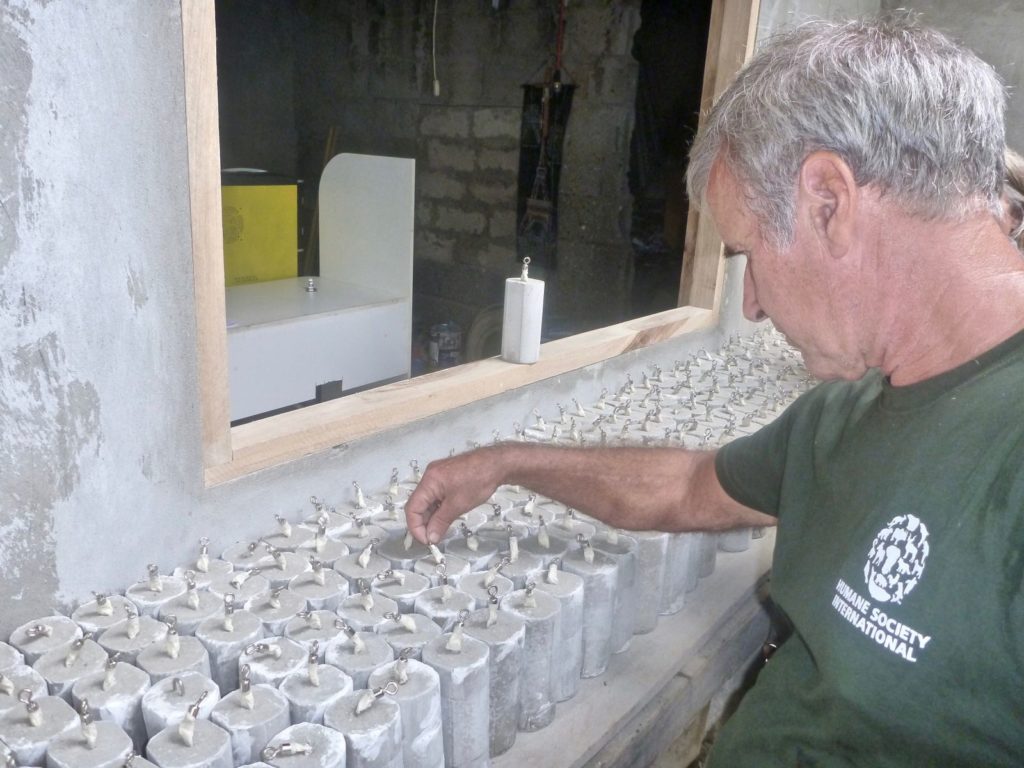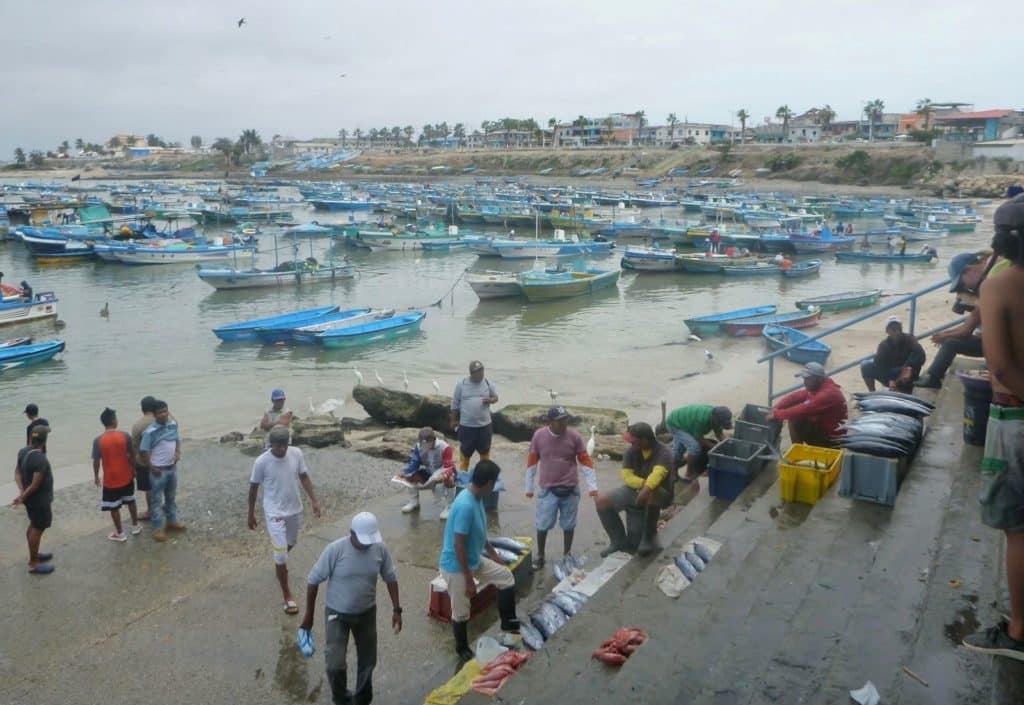One of the most important global meetings on wildlife trade has just wrapped up in Uzbekistan. It’s capital city Samarkand was where governments convened for the 20th Conference of the Parties (CoP20) to the Convention on International Trade in Endangered Species of Wild Fauna and Flora (CITES) to decide how international trade should be managed for some of the world’s most threatened...
The Waved (Galapagos) albatross population has been in persistent decline over the past decade with one of only two island breeding populations now almost extinct. Why? For the same principal reason as the decline of so many of our magnificent albatross and petrel species – death on longline fishing hooks and in nets. Since 2011, Humane Society International has been actively working in South America, and in particular in Ecuador and Peru, in an attempt to reduce the impact of fishing on the Waved Albatross, recently listed as Critically Endangered on the IUCN Red List. This work has been undertaken together with the American Bird Conservancy and with South American conservation organizations Pro Delphinus (Peru) and Equilibrio Azul (Ecuador).
Although the Waved albatross breeds only in Ecuador, it relies extensively on foraging its local waters as well as those of coastal Peru throughout which immense numbers of industrial and artisanal fishing vessels operate. HSI’s seabird expert Nigel Brothers, with extensive practical experience working with fishers to prevent seabird bycatch, has travelled to Ecuador five times since 2011. Nigel works primarily with artisanal hake fishers to give them practical solutions on how to avoid catching and killing seabirds whilst fishing, and trains up locals so that they can learn safe release procedures to ensure that when seabirds are caught they can be released promptly from the hook or net to give them the best chance of survival.

At the start of this important project, little information was known about how or why Waved albatross were being caught in the artisanal fishery. Whilst seabird captures are rare they are often fatal. In Ecuador Nigel worked quickly to ascertain the main problem – the baited lines were simply not sinking fast enough to get out of the birds’ reach. With weights often very basic, such as sand-filled plastic bottles of varying size, using uniform weights was determined as a key requirement to reduce seabird bycatch. Nigel worked to help design and implement a fast setting system and establish a program whereby fishers could have access to free 60g lead centre swivel weights to use on their lines. Simplicity is the secret of the fast setting device which can be constructed at very little expense, from a combination of two long PVC pipes in a special configuration carefully cut from end to end, enabling hundreds of baited hooks to be kept in the correct setting sequence. This allows the fishermen to set their lines at 13 knots compared to the conventional 5 knots. Over the years this fast setting system has been refined and HSI has been pleased to report good uptake by fishers.
In Peru the main focus was to carry out experiments to modify ocean drift nets with the aim of reducing their threat to cetacean, seabirds and sea turtles. Sadly, a disturbing but important demonstration of the utter devastation of drift net use was witnessed during just one net set in 2012. Bycatch included 2 dead Common Dolphins (the female pregnant) and 2 juvenile green turtles. A magnificent adult hammerhead shark was captured, which was in the process of giving birth to 13 young. There were very few fish caught, apart from the hammerhead sharks. Staff at local NGO Pro Delphinus committed to working on the design and fine-tuning of a modified net to reduce the level of unwanted bycatch.


HSI travelled to Ecuador once again in late September 2018 and participated in three important Waved albatross conservation activities. During a meeting convened under the auspices of the Agreement on the Conservation of Albatrosses and Petrels (ACAP) the Waved Albatross Recovery Plan of Action was reviewed and updated. The Action Plan, first developed in 2007 was last updated in 2011, and it relies upon development and implementation of cooperative conservation initiatives by Peru and Ecuador. It is hoped that the recently revised Plan will see more attention focussed on implementing solutions to Waved albatross key threats as well as obtaining a better understanding of optimal nesting requirements and improving estimates of population size and trends. Properly implemented, the Action Plan is capable of also greatly improving the conservation status of additional similarly threatened species such as long-distance visitor from New Zealand the Parkinson’s petrel and Chile’s Pink-footed shearwater and even sea turtles of several species, all of which succumb to the same fate. The Draft Revised Plan will now be considered by the May 2019 Advisory Committee to ACAP, at which Nigel Brothers will once again actively participate representing HSI.
From Guayaquil where the Waved albatross Action Plan meeting was held, HSI travelled to the coast to attend a public meeting of fishermen, who in the course of their fishing accidentally catch many seabirds including Waved albatrosses. HSI, together with conservation partners American Bird Conservancy and Birdlife International have been developing mitigation measures and helping fishermen to implement these over a number of years in the port of Santa Rosa. On this occasion, HSI was able to see progress made in the manufacture and distribution of bird-safe line weights, thanks to the tremendous dedication of in-country project leader, Giovanny Suarez. The public meeting hosted vigorous discussion of wide-ranging topics important to Waved Albatross Recovery efforts. Most encouraging of all was the attitude amongst the fishermen in that they are prepared to help with these efforts, and accept their role in following mitigation requirements. These artisanal fishermen face all manner of threats not only to their livelihoods, but to their very lives. In recent times industrial net boats are taking too much fish, leaving less for them, and there is the constant threat of pirates at sea stealing their boats, sometimes resulting in fishermen deaths. It is easy to see how avoiding the capture of a Waved Albatross or two can be the least of their immediate worries.


Travelling further up the coast to Puerto Lopez, then a 1.5 hour boat journey to Isla de la Plata, enabled HSI to have the opportunity to see first-hand the nesting habitat issues Waved albatrosses are facing. The challenges for them here include historic vegetation-modification by introduced animals such as goats and donkeys together with increasing extremes of weather conditions. If the typical nesting-season overcast skies are disrupted by calm, sunny and very hot days, the birds can be in real trouble from overheating, especially without optimal vegetation cover. Sadly, here on Isla de la Plata, HSI’s visit may well have coincided with the very last Waved albatross breeding attempt. Virtually hidden beneath dense vegetation was just one pair of adult birds attending a lone chick, still with several more hazardous months remaining before the chick will be ready to fledge. Nearby laid a long-ago abandoned egg. Careful consideration is being given to strategies that will ensure nesting association to this breeding site is not entirely lost. Hopefully these strategies can entice breeding back in areas amongst vegetation cover that can optimise breeding success. In contrast to the albatrosses here, stunning Blue-footed boobies and Frigatebirds were nesting in abundance.
There are immense obstacles to the reversal of Critically Endangered Waved albatross decline in a region with complex socio-economic pressures driving staggering levels of local fishing effort. If adequately funded and implemented, the 2018 Recovery Plan of Action will overcome at least some of these obstacles especially if the willingness of fishermen to help, evident already amongst some, is further encouraged. HSI hopes to continue to play a part in this important conservation effort for the benefit of the magnificent Waved albatross, renowned for its somewhat comical and complex courtship dance and astonishing ability to shuffle around juggling its huge egg, reasonably safely. For an albatross species, it is most expressive and quirky and worth every bit of our conservation efforts.


